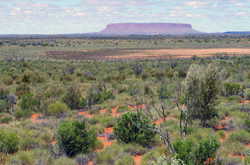Science Highlight
Semi-arid ecosystems emerging role in global carbon cycle dynamics
Poulter, B, D Frank, P Ciais, RB Myneni, N Andela, J Bi, G Broquet, JG Canadell, F Chevallier, YY Liu, SW Running, S Sitch and GR van der Werf. 2014. Contribution of semi-arid ecosystems to interannual variability of the global carbon cycle.
Nature, published online: 21 May 2014
DOI:10.1038/nature13376
Paper Abstract
The land and ocean act as a sink for fossil-fuel emissions, thereby slowing
the rise of atmospheric carbon dioxide concentrations. Although
the uptake of carbon by oceanic and terrestrial processes has kept
pace with accelerating carbon dioxide emissions until now, atmospheric
carbon dioxide concentrations exhibit a large variability on
interannual timescales, considered to be driven primarily by terrestrial
ecosystem processes dominated by tropical rainforests. We use a terrestrial biogeochemicalmodel, atmospheric inversion and global
carbon budget accounting methods to investigate the evolution
of the terrestrial carbon sink over the past 30 years, with a focus on
the underlying mechanisms responsible for the exceptionally large
land carbon sink reported in 2011. Here we show that our three
terrestrial carbon sink estimates are in good agreement and support
the finding of a 2011 record land carbon sink. Surprisingly, we find
that the global carbon sink anomaly was driven by growth of semiarid
vegetation in the Southern Hemisphere, with almost 60 per cent
of carbon uptake attributed to Australian ecosystems, where prevalent
La Nina conditions caused up to six consecutive seasons of increased
precipitation. In addition, since 1981, a six per cent expansion of vegetation cover over Australia was associated with a fourfold
increase in the sensitivity of continental net carbon uptake to precipitation.
Our findings suggest that the higher turnover rates of carbon pools in semi-arid biomes are an increasingly important driver
of global carbon cycle inter-annual variability and that tropical rainforests may become less relevant drivers in the future. More research
is needed to identify to what extent the carbon stocks accumulated
during wet years are vulnerable to rapid decomposition or loss
through fire in subsequent years.
Manuscript
- Download paper: http://www.nature.com/nature/journal/vaop/ncurrent/full/nature13376.html
- Nature News & Views http://www.nature.com/nature/journal/vaop/ncurrent/full/nature13341.html
- Contact lead author: Benjamin Poulter
Media
- Montana State University (more information; pdf, 109kb)
- Climate science: A sink down under (Nature News & Views)
- Record rains made Australia a giant green global carbon sink (The Conversation, >13000 views)
- ABC news
- ABC news blogs
- The Land
- The Guardian
- Sydney Morning Herald
- Nature World News
- Business Insider
- Eureka alert
Illustrative Photos (available free if credited as specified). |
||
|---|---|---|
 |
||
Credit: Eva van Gorsel, CSIRO |
||
